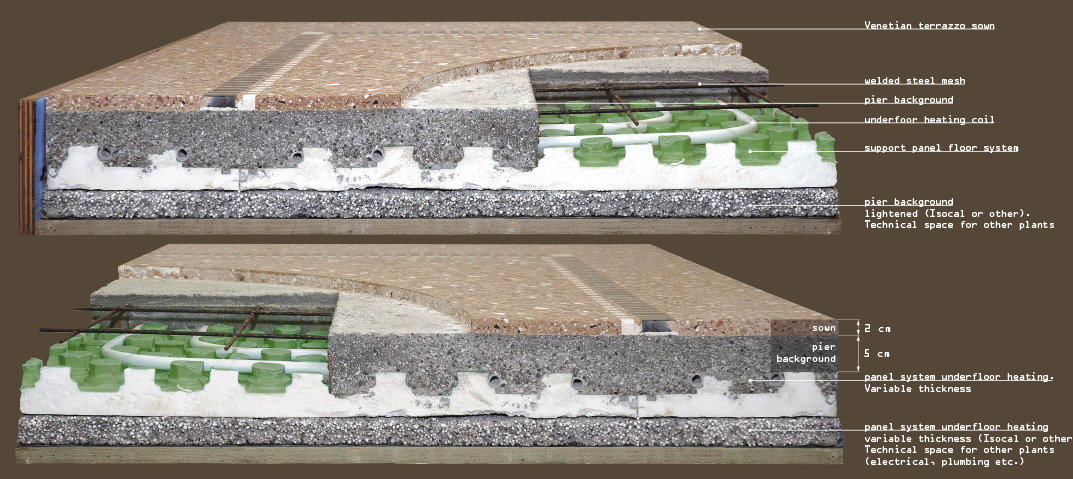
Question and Answer

| Consulting with various companies we found different cost, with significant differences of time. Why? | First you have to make sure that the products compared are complete with all the work, from substrate to wax treatment. The rules for the construction of the terrace are described clearly and in simple “Manuale di Garanzia e Qualità del Consorzio del Terrazzo alla Veneziana” (Assurance Manual and Quality of the Consortium of Venetian Terrazzo), rules that we adhere strictly as we have tried to illustrate in the pages of this presentation. Approximate techniques, operations hasty together with the use of unsuitable materials and low quality, however, usually present to the market a low-cost product that has little or nothing to do with the real terrace “Venetian”.Quality and price are directly proportional factors: there can be a terrace of high quality at low prices, and vice versa! |
| You often see Venetian terrazzo with cracks more or less conspicuous. Why? Can be avoided? |
Careful processing, carried out on time, in the manner and with appropriate materials should avoid the risk of cracks in the surface. It is of paramount importance to identify the positioning of the expansion joints and separation of backgrounds in order to break the tensions present in the body of the terrace. Hairline cracks can be defined as “quibbles shrinkage” barely perceptible to the eye may be accepted as imperfection of a handmade product built on site; extensive cracks and obvious, if not caused by structural failure detected, they are always attributed to errors in the process of work and certainly not acceptable as a product feature. The use of techniques hastyand of low cost materials are the main cause of these drawbacks. In the case of micro-cracking (checking shrinkage) can interfere with a good aesthetic result by sealing with resin; in severe cases it is preferable to demolition and reconstruction of the entire terrazzo. |
| What is the difference between a cement binder terrazzo and a resin? | The terrazzo in cement (or binder mixed lime/cement) is performed with the conventional technique. Everything shown in this presentation — processing steps, materials, installation time and aging — is part of the long tradition of this type of flooring. Trying to play with synthetic materials the original terrazzo “Venetian” has created an artificial copy, a kind of terrace-like that certainly does not improve the original or an aesthetic point of view, nor from the quality, nor and economically. Having no reliable data available can not judge on the issue of eco-sustainability of a product based on epoxy or polyester resin on which we carry out the activities of daily life. |
| How long it takes for the construction of a terrazzo? | The work will performed in stages (subfloor, seeded, coarse sanding, polishing, tertiary) treatment over a period of time estimated for 6/8 weeks. With regard to the last two stages — polishing, final treatment — you can agree on a different timing appropriate to the stage of the yard. |
| Requires maintenance of the terrazzo? | The terrazzo is delivered with a treatment based on natural wax in paste which, in addition to brighten colors and make the surface gloss, constitutes a good protection oleo-hydro repellent. It is recommended to repeat the treatment with protective simple operations to be repeated at least four times a year, namely: · Wash with water and mild detergent; · Waxing with liquid wax-based water; · Polishing with polishing. The operation can be carried out only on the zones of greater trampling. |
| What are the substances that can damage or stain the terrazzo? | Certainly acidic substances, wash often the terrazzo with a detergent inappropriate can ruin the terrace to the point of complete polishing be necessary. Avoid, therefore, to use an acid-based detergents (chlorine), ammonia, bleach, descaling agents (alcohol is fine). It uses preferably a neutral floor detergent, taking care not to over water/detergent to avoid having to wash the floor. Vinegar, fruit juice (orange, lemon, etc…), wine and many other foods that contain acids (acetic acid, citric acid, etc…) cause the typical opaque halo once fallen on the terrace. Incidentally that the effect is common to many other floors, especially marble base, you can change the spot simply with wax — preferably in pasta — by rubbing with a cloth when dry. If the fault persists you can repeat the operation without fear of damaging the floor. In more stubborn cases, you should request the intervention of the Venetian floor craftsmen. Oily stains tend to disappear over time, are in fact absorbed from the terrace in a few weeks. If necessary, you can use them with due care solvents such as nitro thinner, acetone, aviation gasoline. |

